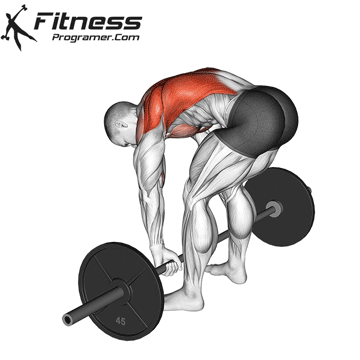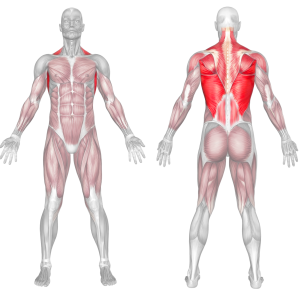Barbell Pendlay Row
The Barbell Pendlay Row is a compound exercise that targets the muscles of the lats, traps, and upper back, while also engaging the core and lower back for stability. By using an explosive pulling motion and brief contact with the floor between repetitions, the Pendlay Row challenges various muscle groups simultaneously, making it an excellent choice for strength training and muscle building.
How to do

- Setup: Stand with your feet shoulder-width apart, toes pointing forward, and the barbell on the floor in front of you. Bend at your hips while keeping your back flat, and grip the barbell with an overhand grip (palms facing down) slightly wider than shoulder-width apart.
- Starting Position: Your back should be parallel to the floor, and your hips should be lower than your shoulders. Keep your chest out, shoulder blades pulled back and down, and your core engaged. This is the starting position.
- The Row: Pull the barbell up towards your lower chest or upper abdomen while keeping your elbows close to your body. Squeeze your shoulder blades together at the top of the movement to engage your back muscles fully.
- Lower the Barbell: Lower the barbell back down to the floor with control, ensuring it makes contact with the ground before starting the next repetition. This brief touch on the ground differentiates the Pendlay Row from other rowing variations, where the weight remains off the floor between repetitions.
- Repeat: Perform the desired number of repetitions.
Tips for Proper Form:
- Keep your back flat throughout the movement, avoiding any rounding or arching of the spine.
- Focus on pulling the weight explosively from the floor to your chest, emphasizing a controlled and quick lift.
Barbell Pendlay Row – Benefits
1. Upper Body Strength: The Pendlay Row is a compound exercise that targets the muscles of the upper back, lats, traps, and biceps. By engaging multiple muscle groups simultaneously, it helps build substantial upper body strength, which is beneficial for various daily activities and athletic performance.
2. Muscle Mass Gain: Due to its focus on major muscle groups, the Pendlay Row is an effective exercise for promoting muscle hypertrophy (muscle growth). Consistent Pendlay Row training can lead to a well-developed and aesthetically pleasing back, showcasing strong and defined upper back muscles.
3. Improved Posture: Strengthening the muscles of the upper back and correcting rounded shoulders can lead to improved posture. The Pendlay Row helps balance muscle development, reducing the risk of postural issues that may arise from modern sedentary lifestyles.
4. Functional Strength: The pulling motion involved in the Pendlay Row mimics movements required in various sports and everyday activities, such as lifting heavy objects from the ground. This functional strength translates to improved performance in real-life situations.
Pendlay Row – Muscles Worked

